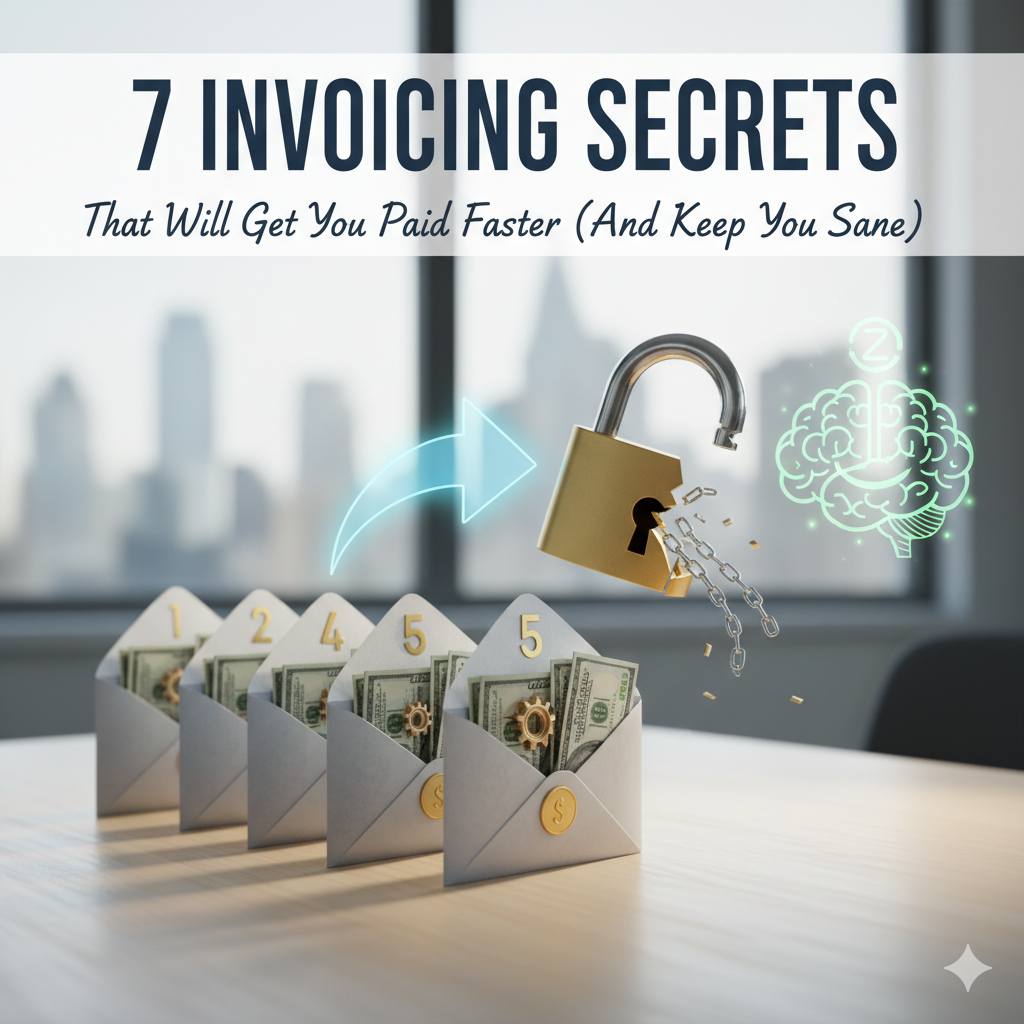Introduction: The Agony of the Unpaid Invoice
Does this scenario sound familiar? You bust your butt creating the perfect content for your client, send over an invoice, and then you wait…and wait…and wait. If you’ve felt that pit in your stomach, you’re not alone. According to data scientists at FreshBooks, 40% of self-employed workers have at least one past-due invoice, averaging over $2,500.
Getting paid on time isn’t about luck; it’s about having the right systems and knowledge in place. It’s a science that involves creating a great invoice, sending it at the right time, and making the entire payment process as smooth as possible for your client.
This article cuts through the noise to bring you the most surprising and impactful takeaways that can transform your invoicing process. These aren’t just tips; they are strategic secrets that will get you paid faster, reduce your stress, and help you treat your finances like the legitimate business owner you are.
The 7 Most Impactful Invoicing Takeaways
1. The Design of Your Invoice Is a Business Tool, Not Just a Bill
Most freelancers see their invoice as a final administrative step. This is a mistake. Strategically, your invoice is your last, best chance to communicate professionalism and remove any friction to getting paid. Treat it like the powerful business tool it is.
- Professionalism: A professionally branded invoice with your logo and a consistent color scheme signals that you are a legitimate business owner. It reinforces your credibility and helps clients take you, and your payment terms, more seriously.
- Frictionless Payments: The easier it is for clients to pay you, the more likely they are to do it promptly. Offer multiple electronic payment options like ACH, credit card, or PayPal directly on your invoice. This eliminates hurdles and gives clients the convenience they expect.
- Clarity is Key: Vague descriptions lead to payment delays. Use crystal-clear line item descriptions that detail exactly what the client is paying for. This prevents confusion, eliminates back-and-forth emails, and stops invoice disputes before they start.
These seemingly small details work together to remove payment friction and reinforce your professional image, making clients more inclined to pay you without a second thought.
2. You’re Probably Sending Your Invoice at the Wrong Time
When it comes to getting paid, when you invoice is just as important as what you invoice. There isn’t one single “right time,” but rather two powerful timing strategies you need to master to ensure consistent cash flow.
- Strategy 1: Invoice Immediately. Many freelancers make the mistake of sending all their invoices at the end of the month. This puts your bill in a queue with every other expense the client has to process. The pro move is to send your invoice the moment the work is completed. Your project is still fresh in the client’s mind, they’re happiest with the value you just delivered, and your invoice is a priority, not just another item on a month-end to-do list.
- Strategy 2: Split Your Billing Cycles. If you manage multiple clients, don’t invoice them all at once. Stagger your billing to ensure payments arrive consistently throughout the month. For example, invoice half of your clients mid-month and the other half at the end of the month. This simple system turns your unpredictable freelance income into a more reliable cash flow.
3. There’s a Shockingly Effective (and Professional) Way to Handle Non-Payers
When polite reminders and phone calls fail, it can feel like you’re out of options. However, there is a powerful, last-resort tool that often works like a charm: professional social shaming.
- The Concept: Companies are extremely sensitive to their social-media reputation. A polite, factual, and public inquiry about an overdue payment can get an immediate response where private emails have failed.
- Example Template: A public message on a platform like X (formerly Twitter) can be highly effective. For example:
“@company—Turned in my final draft 3 weeks ago. Payment now overdue. Please advise when I will see my check?” - Guardrails for Professionalism: To ensure this tactic works for you, not against you, follow these three rules:
- Keep it professional.
- Don’t be rude or call names.
- Stick to the facts.
The reason this works is simple, and it taps into a universal corporate sensitivity:
Publicly “outing” a deadbeat client in social media can really get them off the dime. Every company is paranoid about social-media reputation damage.
- Bonus Tip: Stop working. The moment a client is late on a payment, immediately halt all ongoing work for them. Don’t dig a deeper hole by racking up more unpaid bills. Slow payers earn a trip to the bottom of your priority list. After all, this payment may never arrive.
4. The “Best” Software for You Depends on What You Sell (Services vs. Products)
Choosing accounting software can feel overwhelming, but a simple heuristic can cut your research time in half: are you selling a service or a product? Using FreshBooks and QuickBooks as a classic example, here’s how the distinction plays out.
- For Service-Based Freelancers: A tool like FreshBooks is often a better fit for freelancers and service providers. Its primary strengths are user-friendliness, built-in time tracking on all plans, and a lower price point for its core invoicing function. It’s designed for solopreneurs who need to invoice for their time and services efficiently.
- For Product-Based or Scaling Businesses: A tool like QuickBooks is more suited for businesses that sell physical products or plan to grow into a larger organization. It offers more comprehensive accounting features, advanced inventory management (like low-stock alerts), and no limits on the number of clients you can bill, which is crucial for scaling.
This isn’t just about features; it’s about business trajectory. Choosing FreshBooks is a vote for streamlined simplicity today. Choosing QuickBooks is an investment in scalable complexity tomorrow. Knowing which you’re building towards is the real secret.
5. Your Simple Spreadsheet Might Be More Powerful Than You Think
In a world saturated with SaaS subscriptions, the most overlooked and cost-effective financial command center is likely already on your computer. Before you pay for another monthly plan, let’s master the strategic spreadsheet.
- The Counter-Narrative: A well-organized spreadsheet is a highly effective, customizable, and affordable tool for managing finances. It gives you complete control without the learning curve or cost of complex software.
- Key Features: An effective tracking spreadsheet only needs a few essential columns:
Invoice Number,Client Name,Issue Date,Due Date,Invoice Amount, andPayment Status. - The “Game Changer” Tip: Use conditional formatting to automatically highlight invoice statuses. For example, you can set rules to color overdue invoices red and paid ones green. This gives you an instant, at-a-glance overview of your cash flow and tells you exactly which clients need a follow-up.
- The Power of Habit: The key to making a spreadsheet work is consistency. A simple weekly habit can make a massive difference in keeping your finances organized and stress-free.
Set a weekly reminder to update your spreadsheet. This small habit can save hours of stress during tax time!
6. Getting Your 1099s Wrong Is Easier (and More Expensive) Than You Realize
Tax compliance is a minefield for freelancers and small businesses, and one of the most common points of confusion is the difference between Form 1099-NEC and Form 1099-MISC. Getting this wrong can be costly.
- The Simple Rule: Use Form 1099-NEC (Nonemployee Compensation) to report payments for services from independent contractors. Use Form 1099-MISC (Miscellaneous Information) for other payments like rent or royalties.
- The Deadline Trap: This is where many get caught. The 1099-NEC has a single, strict deadline: January 31 for both the recipient and the IRS. The 1099-MISC, however, has a split deadline: you must send it to the recipient by January 31, but you have until March 31 to file it with the IRS (if filing electronically). Mixing these up is an expensive mistake.
- The Financial Stakes: The IRS takes these filings seriously. Penalties for incorrect or late filings can range from $60 to $660 per form, depending on how late the correction is made. Getting this right is not just good practice—it’s essential for protecting your bottom line.
7. The Siren Song of Self-Hosted Software Could Sink Your Business
The appeal of self-hosted, open-source accounting software is undeniable for many freelancers. It’s often free and promises ultimate control over your financial data. However, this DIY approach comes with significant, often hidden, risks.
- The Appeal: Free software with no subscription fees and total ownership of your data sounds like a win-win for a budget-conscious freelancer.
- The Expert Warning: My advice, and that of every credible accountant, is unequivocal: do not rely on self-hosted services for your business finances unless you are a cybersecurity and accounting expert.
- The Risks:
- Compliance: Accounting is heavily regulated by local laws. Open-source software developed globally may not be compliant with your country’s standards, putting you at legal and financial risk.
- No Support: When a self-hosted tool breaks—and it will—there is no dedicated support team to fix it. A bug in your financial software isn’t an inconvenience; it’s a major liability that could corrupt your data and jeopardize your business.
The smartest business decision is often knowing where your time and expertise are best spent. Paying for a reliable, supported cloud accounting service is an investment in stability and peace of mind, allowing you to focus on your actual work instead of becoming an amateur software technician.
Conclusion: Your Invoice Is Your Final Handshake
Getting paid consistently and on time is not an accident. It’s the direct result of thoughtful systems that treat invoicing as a critical business function, not an administrative afterthought. Your invoice is the final handshake of a project, and it should reflect the same professionalism and care you put into your work.
As you move forward, ask yourself this: What one small change can you make to your invoicing process this week to treat it less like an afterthought and more like the critical business system it is?












